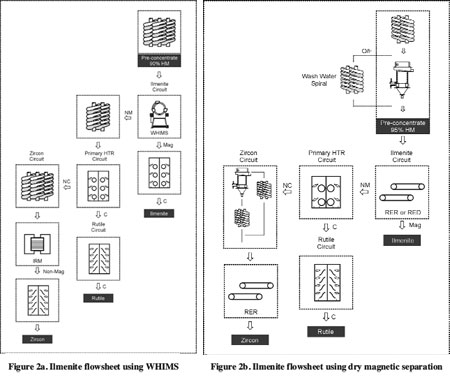 Magnetic separation has long been used to upgrade and beneficiate a wide variety of industrial minerals. Advances in both wet and dry magnetic separators over the years has broadened their use, and questions are often raised about which separation technique or equipment type is most appropriate for a particular operation.
Magnetic separation has long been used to upgrade and beneficiate a wide variety of industrial minerals. Advances in both wet and dry magnetic separators over the years has broadened their use, and questions are often raised about which separation technique or equipment type is most appropriate for a particular operation.
This paper will provide a brief look at existing magnetic separation technologies, and discuss their potential advantages and disadvantages when applied to heavy mineral applications. Relevant case studies for the separation of ilmenite and chromite are then presented. The process development efforts undertaken for each case are described, and the rationale for selecting appropriate magnetic separation technology is explained. The nature of the material being treated must clearly be understood, knowledge and access to testing the best separation technologies is required, and careful process development and economic evaluations are a must.
As is shown in the case study discussions, it is imperative that these principles drive the separation technology selection and placement, rather than looking at typical or existing similar flowsheets as rules.
As examples, the ilmenite tailings case study presented in this paper shows how advances in technology have allowed for increased recovery of -45 μm ilmenite by utilizing a multi-stage Gulin® wet magnetic separator circuit equating to an additional 30 000 tons of ilmenite produced per year. The Gulin chromite case study presented shows that through careful testing and circuit design efforts using RED technology, a 20% increase in overall chromite recovery was achieved over previous demonstration work.
Common practice for magnetic separator placement in mineral sands applications
Wet vs. dry
As a rule of thumb, operations look to reduce drying requirements for obvious cost implications. Employing wet magnetic separation early in a process can greatly benefit an operation if a low-grade final tailing, or a clean marketable product, can be produced, since it alleviates both drying and dry storage costs.
While Wet high-intensity electromagnetic separators(WHIMS) use can be advantageous, a common drawback of conventional designs is entrapment of nonmagnetics in the magnetics product, particularly when treating finer particles. This shortcoming has been addressed with the Gulin® vertically pulsating high gradient magnetic separator (VPHGMS). The advent of the Gulin® machine has extended the use of WHIMS into finer applications previously untreatable by conventional WHIMS or conventional gravity concentration. As an example, recovery of hematite and ilmenite fines with Gulin® technology is now practised widely throughout China. It is also being piloted by many mineral sands producers worldwide, both to replace prior art WHIMS and as a potential intermediate step between traditional WHIMS and dry magnetic separation.
Dry magnetic separators, including both drum and roll types, generally offer far more precise separations than wet magnetic separators. Dry magnetic separation is more controllable since the separation medium is air rather than water. Separating particles from one another is naturally easier without having to fight drag forces created by water. This creates a distinct advantage to using rare-earth dry magnetic separators: the ability to produce a variety of TiO2 products rather than a simple mag/non-mag split. Additionally, rare-earth dry magnetic separation circuits are typically lower in capital and ongoing maintenance costs, and are less complicated to operate than WHIMS.
Rare-earth drum vs. rare-earth roll
A RED is most often used to separate two or more paramagnetic minerals into separate finished products (or semi-finished products for further polishing) in the early stages of a dry separation process flowsheet. Additionally, a RED typically operates at higher unit capacity than a RER separator.
A RER is more commonly applied to residual streams after removal of the more highly susceptible magnetic minerals such as ilmenite, chromite and garnets. A RER is also commonly used for recovery improvements and final cleaning of high-value products, like rutile and zircon, where their higher field strengths are required if proper separation is to occur. For example, the recently developed Gulin® high-efficiency (HE) RER is now being employed in finer zircon-rich applications, and has shown up to a 3% increase in efficiency over conventional RER and IRM units (Elder, 2006).
Induced-roll magnetic separators
IRM separators have historically been used in mineral sands processing. Some remain in various mineral sands circuits but RER separators are rapidly replacing them. The RER allows mineral processors to get over 50% greater capacity per unit operation over IRM separators. This allows for smaller footprints without compromising performance, which equates to substantially reduced costs per ton treated. RER separators offer a reduction of nearly 60% operating costs compared to IRM separators, and the capital cost of a RER is about 30% less than an IRM.
Typical ilmenite process flowsheet
Figures 2a and 2b show basic examples of flowsheets for ilmenite processing including wet and dry magnetic separation.
In Figure 2a, the WHIMS is used after conventional gravity concentration to remove a magnetic stream that can be upgraded easily to finished-product ilmenite. The resulting non-magnetic fraction is then further upgraded by gravity concentration, and followed by conventional dry separation techniques to create the higher value zircon and rutile products.

In Figure 2b, the wet process consists exclusively of gravity concentration followed by a dry plant for fractionating the HMC into various products. In some instances, where high levels of magnetic contaminants exist in the assemblage, electrostatic separation is carried out as the first dry processing stage, followed by magnetic fractionation using a combination of RED and RER separators to produce the various grades of titanium-mineral products.
Typical chromite process flowsheet
In some cases, chromite concentrates can be produced by wet gravity concentration alone. In other chromite beneficiation processes, magnetic separation by RED is an essential polishing step.
Figure 3 shows a typical flowsheet for upgrading chromite where gravity concentration is followed by dry magnetic separation.

